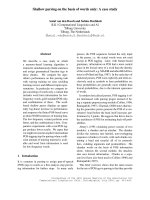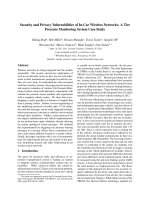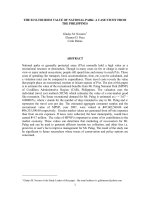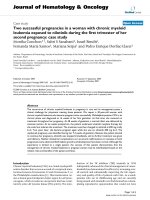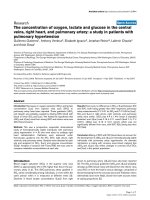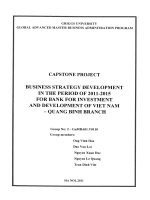Studying the characteristics of heavy rainfall in the central coastal provinces of Vietnam (Quang Binh case study)
Bạn đang xem bản rút gọn của tài liệu. Xem và tải ngay bản đầy đủ của tài liệu tại đây (1.43 MB, 8 trang )
Environmental Sciences | Climatology
Doi: 10.31276/VJSTE.61(2).71-78
Studying the characteristics of heavy rainfall
in the central coastal provinces of Vietnam
(Quang Binh case study)
Nguyen Van Thang1, Vu Van Thang1, Tran Dinh Trong1*, Jerome Faucet2
Vietnam Institute of Meteorology, Hydrology and Climate Change
2
German Red Cross in Hanoi, Vietnam
1
Received 14 September 2018; accepted 3 May 2019
Abstract:
Introduction
This paper explores the maximum amount of rainfall
in the Central coastal provinces of Vietnam (Quang
Binh case study) for return periods of 5 years, 10 years,
20 years, 50 years, and 100 years, which correspond
to frequencies of 20%, 10%, 5%, 2%, and 1%,
respectively. The results show that at a frequency of
20%, the maximum intensity of rain during a heavy
rain spell can range from 636.6 to 696.0 mm, while
the maximum one-day amount received was over
300 mm, which can occur many times in 5 years.
At a frequency of 1%, the intensity of rain during
a heavy rain spell can range from 1,197.9 to 1,268.3
mm, while the maximum one-day amount ranged
from 487.4 to 521.9 mm. However, such values are
very rare over the course of 100 years. In addition,
in terms of annual rainfall, the spatial distribution
of heavy rainfall in coastal areas was significantly
smaller than that in mountainous areas. The highest
one-day and five-day rainfall have the same pattern
of spatial distribution as annual rainfall.
Quang Binh, one of the central coastal provinces of
Vietnam, has a very complex climate and terrain. The
province is the one most affected by natural disasters:
tropical cyclones, floods, and flash floods occur with high
frequency and severity [1-3]. Typhoons and floods usually
occur from September to December, and are concentrated
in October and November. Tropical cyclones lead to heavy
rain and high tides, resulting in floods in the lowland and
flash floods in mountainous areas. Other forms of natural
disasters, such as early floods (‘Lũ tiểu mãn’ or ‘Lũ đầu
mùa’ in Vietnamese), often occur from April to June each
year. On average, two or three floods occur in Quang Binh
every year [4, 5].
Keywords: frequency of extreme rainfall, heavy rain,
temporal and spatial distribution.
Classification number: 5.2
Natural disasters severely affect socio-economic
development and human life. In Vietnam, prevention of
natural disasters and warnings preceding them are still
limited, especially in the provinces, such as Quang Binh,
that are frequently and directly affected by them. With this
in mind, the Vietnam Red Cross (VNRC) and the German
Red Cross (GRC) aim to pilot a new approach called
forecast-based financing that uses forecast-based thresholds
to automatically release money to pay for pre-planned
short-term emergency preparedness action in the critical
time period after a forecast but before a disaster [6].
To support that goal, the GRC and the Center for
Meteorology and Climatology under the Vietnam Institute
of Meteorology, Hydrology and Climate change jointly
signed a research contract entitled “Disasters Profile of
Quang Binh Province and Review and assessment of the
availability and usage of early warning system and Weather
forecasts”. One of the objectives of this contract was to
analyse the disaster profile of Quang Binh, focusing on
heavy rains and floods.
This paper is extracted from the contract’s outcomes,
*Corresponding author: email:
JUne 2019 • Vol.61 Number 2
Vietnam Journal of Science,
Technology and Engineering
71
Environmental Sciences | Climatology
and aims to analyse the characteristics of rain and heavy
rain in the research area, including an analysis of frequency
of extreme rainfalls, and of the temporal and spatial
distribution characteristics of heavy rainfall.
Data and methodology
The data used in this paper are: i) The daily precipitation
observed for the period of 1961-2014 at the three
meteorological stations of Tuyen Hoa, Dong Hoi, and Ba
Don, which is used to calculate the temporal characteristics
of the distribution of rainfall (total precipitation, one-day
maximum precipitation (RX1day), five-day maximum
precipitation (RX5day)); ii) The data set of annual maximum
precipitation and one-day maximum precipitation at these
three meteorological stations, which is used to calculate
the frequency of heavy rain events/one-day maximum
intensity; and iii) Data set from 10 gauge stations (with
at least 30 years of data) in Quang Binh province and six
gauge stations in the neighbouring provinces of Ha Tinh
and Quang Tri, which are used to calculate and map the
spatial distribution of heavy rainfall [7, 8]. Fig. 1 shows
the geographical location and the network of hydrometeorological observation stations used.
Results and discussion
Analysis and evaluation the frequency of heavy rainfall
in Quang Binh province
Frequency of heavy rain events:
Table 1 shows the results calculated for the maximum
amount of rainfall in a heavy rain event based on observations
from 1961 to 2014 at three stations (Ba Don, Dong Hoi,
Tuyen Hoa) in Quang Binh for return periods of 5 years, 10
years, 20 years, 50 years and 100 years (corresponding to
frequencies of 20%, 10%, 5%, 2% and 1%, respectively).
Table 2 shows the number of events in the 1961-2014
period in which the total rainfall was equal to or greater
than average maximum rainfall in a heavy rain spell for the
same return periods shown in Table 1.
Table 1. Calculated maximum rainfall in a heavy rain event
for the given return periods at three meteorological stations in
Quang Binh province (mm).
Stations
Ba Don
Return periods (years)
5
10
20
50
100
636.6
775.4
908.5
1,080.8
1,210.0
Dong Hoi
675.9
802.2
923.4
1,080.3
1,197.9
Tuyen Hoa
696.0
834.5
967.4
1,139.4
1,268.3
Table 2. The number of events during the 1961-2014 period
in which the total rainfall was equal to or greater than the
value calculated for the given return periods at the three
meteorological stations.
Stations
Fig. 1. Geographical location and network of hydrometeorological observation stations.
The methodologies used are the Gumbel Generalized
Extreme Value distribution [9-12] for calculating the
maximum amount of rainfall in Quang Binh for return
periods of 5 years, 10 years, 20 years, 50 years and 100
years, which correspond to frequencies of 20%, 10%,
5%, 2% and 1%, respectively; and climate statistics and
Geographic Information System (GIS) for the temporal and
spatial distribution characteristics of heavy rainfall [13-18].
72
Vietnam Journal of Science,
Technology and Engineering
Return periods (years)
5
10
20
50
100
Ba Don
9
5
2
2
1
Dong Hoi
13
6
2
0
0
Tuyen Hoa
13
5
3
1
0
For 100-year return period (frequency of 1%), this is
very rare occurrence: the calculated maximum rainfall in
an event at each of the three stations in Quang Binh ranged
from 1,197.9 mm to 1,268.3 mm. In fact, in the 54 years’
worth of observed data used in this study, there was only
one event, at Ba Don station, in which the total rainfall
was greater than the calculated value of the 100-year return
period shown in Table 1 (1,350.5 mm in September, 1967).
In addition, in September 1978, a heavy rain event at Ba
Don station reached 1,169.1 mm, which approximates the
calculated rainfall in Table 1. For Dong Hoi and Tuyen
Hoa stations, during the 1961-2014 period, there were no
extreme rainfall events in which the rainfall was equal to
or greater than the calculated threshold of 100-year return
period. At Dong Hoi station, the maximum precipitation
JUne 2019 • Vol.61 Number 2
Environmental Sciences | Climatology
in a heavy rain event was 1,021.7 mm, which occurred in
September, 1979. At Tuyen Hoa station, the total rainfall of
rain events in October 1995 reached approximately 1,236.3
mm, which approximates the calculated rainfall of 100-year
return period.
For 50-year return period (frequency of 2%), the
calculated maximum rainfall in an event at the three
stations in Quang Binh was more than 1,000 mm, with the
highest value, at Tuyen Hoa station, reaching 1,139.4 mm.
For this frequency, in 1961-2014 period, Ba Don station
had two events that exceeded the threshold of 1,000 mm,
in 1967 and 1978. Tuyen Hoa station had one occurrence
that exceeded this threshold, in 1995 (1,236.3 mm), and two
events in which the total rainfall was greater than 1,000 mm
(though still under the threshold), in 2009 (1,008.1 mm) and
2010 (1,037.9 mm). At Ba Don station, there were no events
in which the total rainfall was equal to or greater than the
calculated value, and there was only one event, in 1979, in
which the total rainfall was greater than 1,000 mm.
For 20-year return period (frequency of 5%), the
calculated maximum rainfall in events at the three stations
in Quang Binh were 908.5 mm (Ba Don), 923.4 mm
(Dong Hoi), and 967.4 mm (Tuyen Hoa). According to the
observations during the 1961-2014 period, there were two
events each at Ba Don and Dong Hoi stations and three
events at Tuyen Hoa in which the total rainfall was equal to
or greater than the calculated value of 20-year return period.
For 10-year return period (frequency of 10%), the
calculated maximum rainfall in an event at stations in Quang
Binh ranged from 775.4 mm (Ba Don station) to 834.5 mm
(Tuyen Hoa station). In 1961-2014, these events occurred
five times each at Ba Don and Tuyen Hoa stations, and six
times at Dong Hoi station.
For 5-year return period (frequency of 20%), this is more
frequent occurrence: the calculated maximum rainfall in an
event at each of the three stations in Quang Binh was 636.6
mm, 675.9 mm, and 696.0 mm, at Ba Don, Dong Hoi, and
Tuyen Hoa stations, respectively. According to observations
from the 1961-2014 period, these events occurred nine
times at Ba Don station and thirteen times each at Dong Hoi
and Tuyen Hoa stations. In general, the average maximum
rainfall in an event in the corresponding return period is in
practice comparable to the statistics.
and 1%, respectively). Table 4 shows the number of days
in the 1961-2014 period on which the rainfall was equal to
or greater than the maximum precipitation intensity for the
different return periods presented in Table 3.
Table 3. One-day maximum rainfall intensity for given return
periods at the three stations in Quang Binh province (mm).
Stations
Return periods (years)
5
10
20
50
100
Ba Don
301.2
354.6
405.9
472.2
521.9
Dong Hoi
292.3
339.5
384.8
443.5
487.4
Tuyen Hoa
329.6
391.6
451.0
528.0
585.7
Table 4. The number of days in the 1961-2014 period on which
the rainfall was equal to or greater than calculated intensity
for given return period at the three stations in Quang Binh
province.
Stations
Return periods (years)
5
10
20
50
100
Ba Don
10
6
3
1
1
Dong Hoi
9
3
2
1
1
Tuyen Hoa
11
7
3
1
0
For 100 years return period (frequency of 1%), the
calculated one-day maximum rainfall intensity at the three
stations was 521.9 mm, 487.4 mm, and 585.7 mm at Ba
Don, Dong Hoi and Tuyen Hoa, respectively. However, this
is a very rare event with only one occurrence at each of Ba
Don and Dong Hoi, and no occurrence at Tuyen Hoa during
the 1961-2014 period. In particular, in 54 years’ worth of
observed data used in this study, the maximum one-day
intensity of rainfall was 526.7 mm at Ba Don station (5th
October 2010) and 554.6 mm at Dong Hoi station (9th
October 1995); these are the two days on which the rainfall
intensity at meteorological stations in Quang Binh reached
the calculated threshold value of the 100-year return period.
Frequency of one-day maximum precipitation intensity:
For the 50-year return period (frequency of 2%), the
calculated one-day maximum rainfall intensity was 472.2
mm at Ba Don station, 443.5 mm at Dong Hoi station, and
528.0 mm at Tuyen Hoa station. According to the 19612014 observations used in this study, such an event has
occurred once at each station in Quang Binh. At Ba Don and
Dong Hoi stations, such events were mentioned in the 100year return period, and at Tuyen Hoa station, the maximum
rainfall intensity reaches 548.4 mm on 18th Octorber 1993.
Table 3 shows the results calculated for the one-day
maximum precipitation intensity based on observed data
from the three stations for 1961 to 2014 for the given return
periods of 5 years, 10 years, 20 years, 50 years and 100
years (corresponding to frequencies of 20%, 10%, 5%, 2%,
For the 20-year return period (frequency of 5%), at Ba
Don station, the one-day maximum precipitation intensity
reached 405.9 mm - such an event occurred three times in
the 1961-2014 period. At Dong Hoi station, the one-day
maximum rainfall intensity for the 20-year return period was
JUne 2019 • Vol.61 Number 2
Vietnam Journal of Science,
Technology and Engineering
73
which rainfall was equal to or greater than 329.6 mm at Tuyen Hoa. According to the
observation data for the period 1961-2014, the frequency of occurrence of the one
day maximum rainfall intensity in Quang Binh correlates well with the frequency o
the calculated result of the Gumbel function.
Environmental Sciences | Climatology Temporal distribution of heavy rainfall in Quang Binh province
Annual evolution:
The rainy season in Quang Binh occurs from August to December [16, 17]. Th
384.8 mm, and in the 1961-2014 period there were two days (the time of ‘Tieu Man’ or early floods, when the gradually
temporal
distribution
of rainfall in Quang Binh is a double-peaked annual cycle, with
on which rainfall was equal to or greater than the calculated
strengthening southwest monsoon gradually meets the
the highest
peakweak
in October
and
extra
in May
value. At Tuyen Hoa station, the one-day maximum
rainfall
intrusion
of an
cold
air).peak
The occurring
three months
with (the
the time of „Tieu
intensity and the number of days on which itMan‟
occurred
were floods,
or early
when
the occur
gradually
strengthening
southwest
gradually
highest
rainfall
in autumn
(September,
October, monsoon
and
451 mm and three days, respectively.
meets the weak intrusion
of cold
The three
months
with the
highest
November),
with air).
the monthly
rainfall
reaching
400
mm rainfall occu
in September
and and
600 November),
mm in October.
Thethe
drymonthly
season in
in autumn
(September,
October,
with
rainfall reaching
For 10-year return period, at the three stations
in Quang
Quang
Binh
province
occurs
from
January
to
April,
with
Binh, the one-day maximum rainfall intensity
ranged
from
400 mm in September and 600 mm in October. The dry season in Quang Binh
rainfallto
of April,
less than
50 mm
at most
of the of
stations
339.5 mm at Dong Hoi station to 391.6 mmprovince
at Tuyen occurs
Hoa monthly
from January
with
monthly
rainfall
less than 50 mm a
station. The number of days on which rainfall was equal to (Fig. 2 and Table 5).
most of the stations (Fig. 2 and Table 5).
or greater than the calculated value for 10-year return period
were six, three, and seven days at Ba Don, Dong Hoi, and
Tuyen Hoa stations, respectively.
Monthly rainfall at three stations in
Quang Binh province
700,00
600,00
Rainfall (mm)
For 5-year return period, the number of days on which
rainfall was equal to or greater than the calculated value
for 5-year return period was a more frequent occurrence.
There were 10 days on which rainfall was equal to or greater
than 301.2 mm at Ba Don (one-day rainfall intensity for the
5-year return period), nine days on which rainfall was equal
to or greater than 292.3 mm at Dong Hoi, and 11 days on
which rainfall was equal to or greater than 329.6 mm at
Tuyen Hoa. According to the observation data for the period
1961-2014, the frequency of occurrence of the one-day
maximum rainfall intensity in Quang Binh correlates well
with the frequency of the calculated result of the Gumbel
function.
500,00
400,00
300,00
200,00
100,00
,00
1
2
3
4
5
6
7
8
9
10 11 12
Month
Ba Don
Dong Hoi
Tuyen Hoa
Fig. 2. Annual cycle of rainfall for the period 1961-2014.
Fig. 2. Annual cycle of rainfall for the period 1961-2014.
Table 5. Rainfall characteristics for the 1961-2014 period.
Jan
Feb
Mar
Apr
May
Jun
Jul
Aug
Sep
Oct
One-day maximum rainfall (Rx1day) (A)
7
Nov
Dec
Yearly
Ba Don
21.8
14.8
16.6
25.5
51.7
42.6
39.2
83.0
141.1
176.7
80.8
38.6
235.6
Dong Hoi
22.8
17.9
21.8
29.0
51.1
40.5
34.6
74.2
146.7
179.4
94.3
44.8
234.2
Tuyen Hoa
15.5
15.1
21.4
31.8
59.7
54.5
57.3
104.1
150.5
192.7
66.4
25.9
253.4
Five-day maximum rainfall (Rx5day) (B)
Ba Don
31.7
22.4
22.4
33.2
68.4
63.6
58.5
125.8
247.1
331.6
136.8
61.3
418.2
Dong Hoi
34.5
26.7
28.2
38.1
66.8
58.5
53.4
114.8
268.7
360.6
169.0
74.7
450.7
Tuyen Hoa
25.8
24.5
30.0
41.8
91.4
91.1
87.4
166.1
268.0
366.6
112.4
43.7
462.4
Number of days with rainfall greater than 50 mm (R50) (C)
Ba Don
0.0
0.0
0.0
0.2
0.5
0.4
0.5
0.9
2.3
3.6
1.2
0.3
9.7
Dong Hoi
0.1
0.1
0.1
0.3
0.7
0.3
0.3
0.9
2.6
4.0
1.8
0.4
11.5
Tuyen Hoa
0.0
0.0
0.0
0.2
0.6
0.5
0.7
1.1
2.8
3.8
0.9
0.1
10.7
Temporal distribution of heavy rainfall in Quang Binh
province
Annual evolution:
The rainy season in Quang Binh occurs from August to
December [16, 17]. The temporal distribution of rainfall
in Quang Binh is a double-peaked annual cycle, with the
highest peak in October and an extra peak occurring in May
74
Vietnam Journal of Science,
Technology and Engineering
Over a year, the one-day maximum rainfall at the three
stations in Quang Binh ranged from 234.2 mm to 253.4 mm
(Table 5A). The one-day maximum rainfall is often observed
during the rainy season and is concentrated in September
and October. On average, for the 1961-2014 period, the
one-day maximum rainfall at the three stations in Quang
Binh ranged from 141.1 mm to 150.5 mm in September, and
from 176.7 mm to 192.7 mm in October (Fig. 3).
JUne 2019 • Vol.61 Number 2
a
0.0
0.0
0.0
0.2
0.6
0.5
0.7
1.1
2.8
3.8
0.9
0.1
10.7
Rainfall (mm)
Over a year, the one-day maximum rainfall at the three stations in Quang Binh
ged from 234.2 mm to 253.4 mm (Table 5A). The one-day maximum rainfall is
en observed during the rainy season and is concentrated in September and October.
Sciences | Climatology
average, for the 1961-2014 period, the one-day maximum rainfall at the Environmental
three
tions in Quang Binh ranged from 141.1 mm to 150.5 mm in September, and from
6.7 mm to 192.7 mm in October (Fig. 3).
On average, for the 1961-2014 period, the annual
Maximum one-day rainfall at three stations in
maximum five-day rainfall at the three stations in Quang
Quang Binh province
Binh province ranged from 418.2 mm to 462.4 mm
250,00
(Table 5B). The maximum five-day rainfall also occurs in
200,00
150,00
September and October, with values from 247.1 mm to
100,00
268.7 mm in September and from 331.6 mm to 366.6 mm
50,00
,00
in October (Fig. 4).
1
2
3
4
5
6
7
8
9
10
11
12
In terms of the annual occurrence of heavy rainfall, the
three stations in Quang Binh province witness approximately
10-11 days of heavy rain (Table 5C). Similar to the maximum
400,00
Fig. 3. of
Annual
cycle of the maximum
rainfall
for the
g. 3. Annual cycle
the maximum
one-dayone-day
rainfall
for the
period
1961-2014.
daily
rainfall, the heavy rain days often occur in the rainy
300,00
period 1961-2014.
200,00
season, especially in September and October. At the three
100,00
stations,
on average
for the 1961-2014 period, there were
On average, for the
1961-2014
period,
annual
maximum
five-day
rainfall
at
Maximum
five-day
rainfallthe
at three
stations
in
,00
1
2
3
4
5
6
7
8
9
10
11
12
Quang
Binh
province
approximately
2-3
heavy
rain days in September, and 3-4
three stations in Quang Binh province ranged from 418.2 mm to 462.4 mm (Table
Month
400,00
October. with
From January to April, heavy rain days rarely
). The maximum five-day
rainfall also occurs in September and in
October,
Ba Don in Dong
Hoi
Tuyenand
Hoa from 331.6 mm
ues from 247.1 mm300,00
to 268.7 mm
September
to
366.6
mmBinh (Fig. 5).
occur in Quang
200,00
October
4). cycle
Fig.(Fig.
4. Annual
100,00of the maximum five-day rainfall for the period 1961-2014.
Analysis of rainfall trends in Quang Binh:
Month
Rainfall (mm)
Rainfall (mm)
Maximum five-day rainfall at three stations in
Ba Don
Dong Hoi
Tuyen Hoa
Quang Binh province
,00
8
1
2
3
4
6
7
8
9
10 11 12
Figure 6 shows the trends in annual rainfall at the three
In terms of the annual
occurrence
of5 heavy
rainfall,
the
three stations in Quang
Month
stationstofor the period of 1961-2014. In general, the trends
Binh province witness approximately 10-11 days of heavy rain (Table 5C). Similar
the maximum daily rainfall,Bathe
heavy
rain
days
often
occur
in
the
rainy
inseason,
annual rainfall vary greatly between stations. Annual
Don
Dong Hoi
Tuyen Hoa
especially in September and October. At the three stations, on average for the
1961rainfall increased by 37.6 mm and 58.9 mm per decade
Fig. 2014
4. Annual
cycle
of the
maximum
five-day
rainfall
for
the
1961-2014.
period,Fig.
there
were
approximately
2-3
heavyfive-day
rain days
in September,
3-4 Don
in and Tuyen Hoa stations, respectively, while it
4. Annual
cycle
of the maximum
rainfall
forperiod
the and
at Ba
period
1961-2014.
October. From January to April, heavy rain days rarely occur in Quang Binh (Fig. 5).
Days
decreased by approximately 46.2 mm per decade at Dong
In terms of the annual occurrence of heavy rainfall, the three stations in Quang
Hoi station.
Binh province witness approximately
of stations
heavy inrain (Table 5C). Similar to
Number of heavy10-11
rain daydays
at three
Quang Binh
Figure
7 shows the trends in annual maximum one-day
he maximum daily rainfall, the heavy
rainprovince
days often occur in the rainy
season,
5,00
rainfall
at the three stations in Quang Binh province. For the
especially in September and October. At the three stations, on average for
the 19614,00
period
1961-2014,
the annual Rx1day experienced positive
2014 period, there were approximately 2-3 heavy rain days in September, and 3-4 in
3,00
October. From January to April, heavy rain days rarely occur in Quang Binh
(Fig.
5). of 4-16 mm per decade. The annual Rx1day
trends
at rate
2,00
rate
of
decrease
at Ba Don station was the fastest in the
1,00
province, approximately 15.98 mm per decade.
,00Number of heavy rain day at three stations in
1
2
3
4
5
6
7
8
Quang Binh province
9
10
11
12
Figure 8 shows the trends in annual maximum fiveday
rainfall (Rx5day) at the three stations in Quang Binh
Ba Don
Dong Hoi
Tuyen Hoa
4,00
for the period of 1961-2014. It can be seen that, similarly
Fig. 5. Annual3,00
cycle of the number of rainy days over 50 mm for the period
Fig. 5. Annual cycle of the number of rainy days over 50 mm for
to the annual rainfall, the trend in Rx5day change at the
1961-2014. the2,00
period 1961-2014.
three stations was not uniform but alternated between an
Analysis1,00
of rainfall trends in Quang Binh:
Month
Days
5,00
Figure 6 ,00
shows the trends in annual rainfall at the three stations for the period
1
2 the 3trends
4 in 5annual
6 rainfall
7
8 vary
9 greatly
10
11between
12
of 1961-2014. In general,
stations.
Month
Annual rainfall increased by 37.6 mm and 58.9 mm per decade at Ba Don and Tuyen
Ba Don
Dong Hoi
Tuyen Hoa
9
Fig. 5. Annual cycle of the number of rainy
days over 50 mm for the period
1961-2014.
Analysis of rainfall trends in Quang Binh:
Figure 6 shows the trends in annual rainfall at the three stations for the period
of 1961-2014. In general, the trends in annual rainfall vary greatly between stations.
Fig. 6. Trends in rainfall at the three stations in Quang Binh, 1961-2014.
Annual rainfall increased by 37.6 mm and 58.9 mm per decade at Ba Don and Tuyen
9
JUne 2019 • Vol.61 Number 2
Vietnam Journal of Science,
Technology and Engineering
75
Environmental Sciences | Climatology
Fig. 7. Trends in Rx1day at the three stations in Quang Binh, 1961-2014.
Fig. 8. Trends in Rx5day at the three stations in Quang Binh, 1961-2014.
Fig. 9. Trends in R50 at the three stations, 1961-2014.
upward trend and a decline over the 54 years. Specifically,
the Rx5day tended to increase at Ba Don and Tuyen Hoa
stations, with increases of 1.7 mm/decade and 18.4 mm/
decade, respectively, while a downward trend occurred at
Dong Hoi station, at 26.4 mm/decade.
Figure 9 shows the trends in number of heavy rain days
(R50) at the three stations for the period of 1961-2014.
Similar to the annual rainfall, R50 showed increasing trends
at Ba Don and Tuyen Hoa stations, at a rate of 0.1 and 0.3
days per decade, respectively, and a decreasing trend at
Dong Hoi station, at a rate of approximately 0.55 days per
decade.
76
Vietnam Journal of Science,
Technology and Engineering
Spatial distribution of heavy rain in Quang Binh
province
Distribution of the annual average total rainfall:
The average total rainfall is in the 2,000 to 2,400 mm
range in Quang Binh province. Rainfall in coastal areas is
significantly lower than in mountainous areas. For instance,
the lowest annual average rainfall is in the coastal district of
Quang Trach, with a value of about 1,900 mm. The highest
rainfall is concentrated in two regions: the mountainous
areas along the border with Laos and the northern border
abutting the Ky Anh heavy rain centre (one of the highest
rainfall centres in Vietnam is located in Ky Anh province),
with rainfall from 2,200 to over 2,800 mm (Fig. 10).
JUne 2019 • Vol.61 Number 2
Environmental Sciences | Climatology
Fig. 10. Spatial distribution of the average total rainfall in
Quang Binh province.
Distribution of the maximum one-day rainfall:
The maximum one-day rainfall in Quang Binh province
ranges from 230 and 280 mm (Fig. 11). The RX1day shows
obvious differentiation, with the highest values in the north
and west of Quang Binh, and the lowest values in the east.
The largest value for RX1day was found at Dong Tam
station (Tuyen Hoa district), while the lowest value was
found at Dong Hoi station (Dong Hoi city).
Fig. 11. Spatial distribution of the maximum one-day rainfall in
Quang Binh province.
Distribution of the maximum five-day rainfall (RX5day):
The maximum consecutive five-day rainfall (RX5day)
in Quang Binh ranges from 400 to 500 mm (Fig. 12). The
distribution of RX5day is quite similar to that of the RX1day
- the largest values are in the north and west and the lowest
values in the east. The largest value for RX5day was found
at Dong Tam station (Tuyen Hoa district), while the lowest
value was found at Ba Don station (Quang Trach district).
Fig. 12. Spatial distribution of the maximum consecutive fiveday rainfall in Quang Binh province.
Distribution of the number of days with rainfall greater
than 50 mm (R50):
Figure 13 shows the spatial distribution of the number of
days with rainfall greater than 50 mm in Quang Binh. The
values for R50 range from about 10 to 13 days per year for
the whole of Quang Binh province. The lowest value was
found at Minh Hoa and Ba Don stations with 9.7 days, while
the highest is 13.4 days at Kien Giang station.
Fig. 13. Spatial distribution of the number of days with rainfall
greater than 50 mm in Quang Binh province.
Conclusions
Quang Binh province is greatly affected by natural
disasters, with tropical cyclones, floods, and flash floods
occurring at high frequency and severity. In-depth study
of heavy rainfall is highly relevant for supporting socioeconomic development and human life in Vietnam in
general and in Quang Binh in particular.
The maximum rainfall during one heavy spell of
rainfall and the one-day heavy rainfall were calculated
JUne 2019 • Vol.61 Number 2
Vietnam Journal of Science,
Technology and Engineering
77
Environmental Sciences | Climatology
according to the frequency of occurrence of 20%, 10%,
5%, 2%, and 1% (i.e., the 5-year, 10-year, 20-year, 50year, and 100-year return periods). The results show that
at the frequency of occurrence of 20%, the maximum
intensity of a heavy rain spell can reach from 636.6
to 696.0 mm, and this can occur many times in five
years. Conversely, at a frequency of 1%, the intensity
of a heavy rain spell can reach 1,197.9 to 1,268.3 mm;
however, this value is very rare in 100 years.
[4] Xuan Hau Nguyen (2015), Assessment of the impact of climate
change on the flooding of Nhat Le basin, Quang Binh province, Vietnam
Academy of Science and Technology.
In terms of the maximum one-day rainfall, at the
frequency of occurrence of 20%, the maximum one-day
reached over 300 mm, and this can occur many times
in five years. Conversely, at a frequency of 1%, the
maximum one-day can reach from 487.4 to 521.9 mm;
however, this value is very rare in 100 years.
[7] Dai Nguyen (2007), Collecting and adjusting hydrometeorological data of Quang Binh province from 1956 to 2005,
Synthesis report of the provincial level project.
For the period 1961-2014, the average annual rainfall
in Quang Binh ranged from 2,000 to over 2,400 mm,
with the rainy season lasting from August to December
and peaking in October. In terms of spatial distribution,
rainfall in coastal areas was significant lower than in
mountainous areas. The highest rainfall was concentrated
in two regions: the mountainous areas along the border
with Laos and the northern area bordering on the Ky Anh
heavy rain centre, where rainfall from over 2,200 mm to
over 2,800 mm was recorded. The highest one-day and
five-day rainfall has the same pattern of distribution as
the annual rainfall.
ACKNOWLEDGEMENTS
This paper is part of a research contract entitled
‘Disasters Profile of Quang Binh Province and Review
and Assessment of the Availability and Usage of
Early Warning System and Weather Forecasts’, jointly
signed by the GRC and the Center for Meteorology
and Climatology, with financial support from the Boll
Foundation (Boll Stiftung). The authors acknowledge
the support and contribution of the VNRC and the GRC.
In addition, special thanks are given to the research
team at the Center for Meteorology and Climatology
for participating in the research, and supporting and
contributing to the completion of this paper.
The authors declare that there is no conflict of interest
regarding the publication of this article.
REFERENCES
[1] />
[5] Long Duc Vu (2014), Research on developing technology for flood
warning, forecasting and flooding warning for main rivers in Quang Binh,
Quang Tri provinces, Synthesis report of the ministerial level project.
[6] GRC, VNRC (2017), Community-based disaster management
in rural and urban areas in Quang Binh (2015-2018), Boll Foundation
sponsed project.
[8] Vietnam Meteorological and Hydrological Administration (2017),
Observation data set of meteorology and hydrology, updated to 2017.
[9] Francesco De Paola, Maurizio Giugni, Maria Elena
Topa, and Edoardo Bucchignani (2014), “Intensity-Duration-Frequency
(IDF) rainfall curves, for data series and climate projection in African
cities”, Springerplus, 3, p.133, Doi: 10.1186/2193-1801-3-133.
[10] S.C. Liew, S.V. Raghavan and S.-Y. Liong (2014), “How to
construct future IDF curves, under changing climate, for sites with scarce
rainfall records?”, Hydrol. Process, 28, pp. 3276-3287, doi: 10.1002/
hyp.9839.
[11] L.M Nhat, Y.Tachikawa, K. Takara (2006), “Establishment of
intensity-duration-frequency curves for precipitation in the monsoon
area of Vietnam”, Annuals of Disas. Prev. Res. Inst., 49B, Kyoto
University.
[12] X. Wang, G. Huang and J. Liu (2014), “Projected increases in
intensity and frequency of rainfall extremes through a regional climate
modeling approach”, J. Geophys. Res. Atmos., 13, pp.271-13,286, doi:
10.1002/2014JD022564.
[13] Binh Thai Hoang (2009), Developing flood maps at
downstream area of Nhat Le river system (My Trung - Tam Lu - Dong
Hoi), Graduate thesis, VNU University of Science.
[14] Cam Vinh Lai, Hau Xuan Nguyen (2007), Study and
implementation on online forecasting technology on the area and level
of flooding in river basins of Central Vietnam, Synthesis report of the
project, Vietnam Institute of Science and Technology.
[15] K. Dairaku, K. Kuraji, M. Suzuki, N. Tang
Tham, W. Jirasuktaveekul, and K. Punyatrong (2000), “The effect
of rainfall duration and intensity on orographic rainfall enhancement
in a mountainous area: a case study in the Mae Chaem watershed,
Thailand”, J. Japan Soc. Hydrol. Water Resour, 13, pp.57-68.
[16] T. Oki and K. Musiake (1994), “Seasonal change of the
diurnal cycle of precipitation over Japan and Malaysia”, J. Appl.
Meteor., 33, pp.1445-1463.
[2] Duc Ngu Nguyen, Hieu Trong Nguyen (2013), Climate
and climate resources in Vietnam, Hanoi Science and Technology
Publishing House.
[17] Oyebande (1982), “Deriving rainfall intensity-durationfrequency relationships and estimates for regions with inadequate
data”, Hydrological Science Journal, 27(3), pp.353-367.
[3] Duc Ly Nguyen, Hai Duong Ngo, Dai Nguyen (2013), Quang
Binh climate and hydrology, Hanoi Science and Technology Publishing
House.
[18] A.K. Weisse and P. Bois (2001), “Topographic effects
on statistical characteristics of heavy rainfall and mapping in the
French”, J. Appl. Meteor., 40, pp.720-740.
78
Vietnam Journal of Science,
Technology and Engineering
JUne 2019 • Vol.61 Number 2


